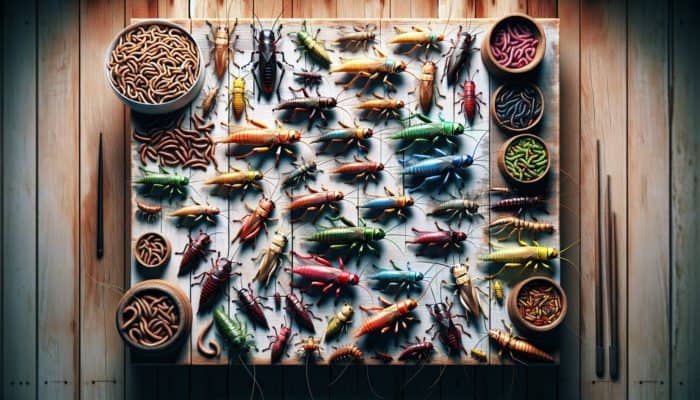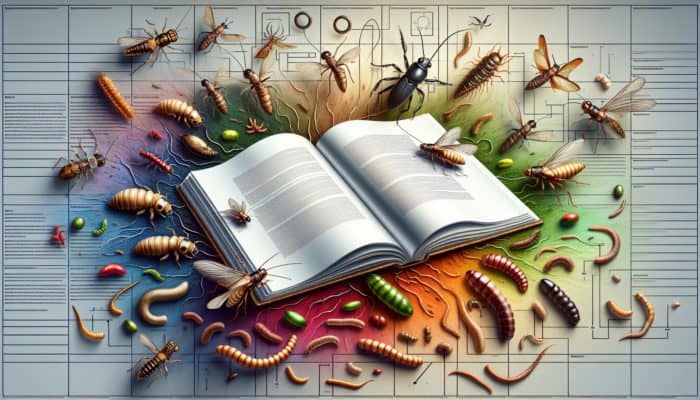Exploring the Intriguing Realm of Edible Insects
What Are Edible Insects and What Makes Them Significant?

The Edible Insects Guide delves into the various species of insects deemed safe and nutritious for human consumption. These edible insects are not merely a food novelty; they are a vital part of traditional diets in numerous cultures, providing a sustainable and rich source of protein. The growing acceptance of insects as a viable food source is propelled by their exceptional nutritional value as well as their notable environmental benefits. Some of the widely consumed edible insect species around the globe comprise:
- Crickets
- Mealworms
- Grasshoppers
- Ants
- Termites
- Silkworms
- Beetles
- Waxworms
In numerous regions, the practice of consuming these insects is steeped in tradition, showcasing their adaptability and acceptance as a legitimate food source.
Unveiling the Nutritional Value of Edible Insects
Edible insects are highly regarded for their remarkable nutritional profiles, which often rival or even exceed those of conventional animal products. Loaded with high-quality protein, essential fatty acids, vitamins, and minerals, they present an excellent alternative to traditional meats. Notable nutrients found in various edible insects include:
- Protein (up to 80% of their dry weight)
- Omega-3 and Omega-6 fatty acids
- Iron
- Zinc
- Calcium
- B vitamins (including B12 and riboflavin)
- Fiber (derived from chitin in exoskeletons)
- Antioxidants
This extensive array of nutrients not only positions insects as a sustainable option but also as a beneficial addition to dietary practices focused on enhancing overall health and wellness.
Why Should We Consider Including Insects in Our Diets?
The advantages of incorporating insects into our diets extend far beyond their impressive nutritional content. They represent an environmentally sustainable option, necessitating far fewer resources for production compared to traditional livestock. Insects exhibit a remarkably efficient feed-to-protein conversion rate, leading to reduced greenhouse gas emissions and lower water consumption. As the global population continues to rise, integrating insects into our diets presents a practical solution to pressing food security challenges. Furthermore, insects offer unique culinary experiences, introducing exciting flavours and textures to familiar dishes.
Professional Insights on the Edible Insects Guide

Real-World Uses of Insect Consumption
Insects have been a staple in the diets of various cultures around the globe for centuries. In Thailand, fried crickets are a cherished street food celebrated for their crunchy texture and delightful flavour. In Mexico, chapulines, or toasted grasshoppers, are seasoned with garlic and lime, frequently served alongside tortillas. In Japan, insects such as *inago* (grasshoppers) are commonly prepared with a sweet soy sauce glaze and savoured as a delicacy. These traditional recipes not only hold cultural significance but also demonstrate the incredible versatility of edible insects within local cuisines. Their integration into these culinary practices underscores the rich and diverse applications of insects in cooking.
What Best Practices Should Be Implemented for Sustainable Insect Farming?
The practice of insect farming, known as entomoculture, can be optimised by adopting best practices that encourage sustainable growth and breeding. Key factors include establishing optimal conditions for temperature and humidity that replicate the insects' natural environments. For instance, crickets flourish at temperatures between 25-30°C and require humidity levels of approximately 60-70% for ideal growth. Additionally, selecting suitable feed is vital; insects can efficiently consume organic waste, thereby reducing feed costs and promoting sustainability. Implementing strategies such as vertical farming can maximise space utilisation and diminish environmental impacts. By following these practices, insect farms can produce protein efficiently while significantly decreasing resource consumption.
How Can We Seamlessly Integrate Insects into Our Contemporary Diets?

Integrating insects into modern diets can be approached gradually, ensuring the experience is enjoyable and accessible for those unfamiliar with entomophagy. Starting with insect snacks, such as roasted crickets or protein bars made from cricket flour, serves as a fantastic introduction. Adding insects to familiar dishes makes the transition smoother; for example, incorporating mealworms into pasta, pizza, or salads enriches their nutritional value without altering the essence of the dish. Establishing a foundation of acceptance through manageable portions permits a gradual increase in consumption over time. This incremental integration encourages more individuals to embrace insects in their regular eating habits.
What Nutritional Advantages Can Be Gained from Consuming Insects?
The nutritional benefits of consuming insects are considerable, rendering them a highly valuable addition to a balanced diet. Many insect species boast a protein content of up to 80% by dry weight, comparable to or even exceeding that of traditional meats such as beef and poultry. Additionally, they are abundant in essential fats, vitamins, and minerals crucial for overall health. For instance, crickets not only provide high protein levels but also significant quantities of iron and zinc, which are vital for immune function and energy metabolism. Integrating insects into one’s diet can effectively assist individuals with dietary restrictions, enhancing nutrient intake while promoting sustainability.
Examining the Health Benefits of Consuming Edible Insects
What Health Benefits Can Be Derived from Eating Insects?
Incorporating insects into our diets yields a plethora of health benefits, primarily due to their nutrient-dense composition. They serve as an excellent source of high-quality protein, essential for muscle growth and repair. Furthermore, insects are packed with vital vitamins and minerals contributing to overall well-being. The health benefits associated with insect consumption include:
- Enhanced muscle growth and repair
- Boosted immune function due to high zinc levels
- Improved digestive health owing to fiber content
- Increased satiety which aids in weight management
- Support for heart health through healthy fats
- Potential anti-inflammatory effects from certain insect species
- Enhanced energy levels resulting from a balanced nutrient profile
- Increased micronutrient intake through a variety of insect species
These benefits illustrate how the integration of insects into diets can have a positive impact on health and well-being, particularly in areas grappling with nutrient deficiencies.
What Important Considerations Should We Have Regarding Allergies and Safety Concerns?
While insects are generally considered safe for consumption, some individuals may experience allergic reactions to them. Those with shellfish allergies should exercise particular caution, as the protein structures in insects can be quite similar. To mitigate potential risks, it is vital to source insects from reputable suppliers who adhere to stringent safety standards. Employing proper cooking techniques, such as ensuring adequate cooking temperatures, can further enhance safety. Additionally, consumers should be vigilant about contamination issues and should refrain from consuming wild-caught insects unless their safety and hygiene can be guaranteed.
How Do Insects Provide Essential Nutrients to Our Diet?
Insects are a rich source of essential nutrients that are crucial for maintaining a balanced diet. They frequently contain high levels of iron, which is essential for oxygen transport in the bloodstream, along with zinc, which bolsters immune health and healing. B vitamins, particularly vitamin B12, present in insects are vital for energy metabolism and the health of the nervous system. These nutrients can be especially advantageous for individuals with dietary restrictions, such as vegetarians or those with food allergies. By including insects in their diets, individuals can significantly enhance their nutrient intake.
Guidelines for Preparing and Cooking Edible Insects
What Are the Key Preparation Methods for Edible Insects?
Preparing insects for consumption involves various methods that can significantly enhance their flavour and texture. The fundamental steps consist of cleaning, cooking, and seasoning. Initially, insects should be thoroughly cleaned to remove any debris or contaminants. Boiling is a common technique that ensures they are cooked properly while retaining moisture. Roasting enhances their crunchiness, making them ideal for snacking. Frying adds a layer of flavour and richness. Each preparation method can be tailored to individual tastes, allowing for unique culinary experiences with insects as the star ingredient.
What Are Some Popular Recipes Featuring Edible Insects?
Insects can be creatively incorporated into a diverse range of dishes, spanning from appetizers to main courses. Some popular recipes that highlight edible insects include:
- Cricket flour pancakes: Crafted by substituting traditional flour with cricket flour, providing a protein-packed breakfast option.
- Mealworm stir-fry: Enhancing a vegetable stir-fry with mealworms for added texture and nutrition.
- Chocolate-covered ants: A sweet treat that pairs the crunch of ants with rich chocolate flavour.
- Grasshopper tacos: Featuring toasted grasshoppers as a filling, seasoned with spices, and served in tortillas.
- Insect protein bars: Blending nuts, dried fruits, and insect protein for a nutritious snack.
- Silkworm stew: A traditional dish where silkworms are cooked with vegetables and spices for a hearty meal.
- Fried crickets with lime: A simple yet flavourful snack enjoyed with a sprinkle of salt and a squeeze of lime.
- Insect-based pasta: Incorporating insect protein into pasta dough for a novel twist on classic dishes.
These recipes highlight the versatility of insects and assist in making them more approachable for those who may be new to their culinary potential.
What Tips Can Elevate the Flavour of Insects?
Insects can be seasoned with a variety of spices and incorporated into sauces to elevate their flavour profile. Utilising bold spices such as chili powder, garlic, and cumin can significantly enhance the taste of insect-based dishes, rendering them more appealing. Moreover, experimenting with marinades or sauces—such as teriyaki or garlic butter—can add depth and richness to the final dish. Pairing insects with complementary ingredients like avocados, fresh herbs, or citrus can further enhance their allure. Creative seasoning can transform simple insect dishes into gourmet experiences while catering to diverse palates.
Assessing the Environmental Impact of Consuming Insects
How Sustainable Is Insect Farming Compared to Traditional Livestock?
Insect farming is acknowledged for its sustainability when compared to traditional livestock farming. Insects necessitate significantly less land, water, and feed to generate comparable amounts of protein. For instance, crickets require approximately 1,700 times less land and 1,000 times less water than cattle to achieve the same protein output. Furthermore, insect farming results in markedly lower greenhouse gas emissions, establishing it as an eco-friendly alternative. The ability to utilise organic waste as feed further enhances sustainability, transforming food waste into a valuable resource. Supporting insect farming can navigate us towards a more sustainable food system that benefits both humanity and the environment.
How Does Choosing Insects Mitigate Environmental Impact?
Opting to consume insects instead of traditional meats can significantly reduce one’s carbon footprint. Insects are exceptionally efficient at converting feed into protein, requiring less feed and generating less waste compared to conventional livestock. For example, crickets convert feed into body mass at an approximate rate of 2:1, while cattle necessitate a conversion rate of up to 8:1. This efficiency leads to decreased greenhouse gas emissions and reduced resource consumption on a broader scale. Additionally, since insects can thrive on organic waste, their farming can address food waste issues, positively impacting the environment while tackling food security challenges.
How Can Insect Farming Contribute to Biodiversity?
Insect farming can significantly contribute to biodiversity conservation by lessening reliance on large-scale livestock farming, which often results in habitat destruction and monocultures. By integrating insects into food systems, we can promote agricultural practices that support local ecosystems and biodiversity. Insect farms can also aid conservation efforts by incorporating native insect species, thus preserving genetic diversity. The potential positive impacts on biodiversity from sustainable insect farming underscore the importance of integrating insects into future food production strategies, aligning agricultural practices with ecological preservation.
Research-Driven Insights on Edible Insects
What Insights Do Scientific Studies Provide About Insects?
Scientific research increasingly endorses the consumption of insects as a nutritious and sustainable food source. Studies underscore the rich nutritional profiles of various edible insects, showcasing their potential to address global food challenges such as malnutrition and food insecurity. Real-world examples demonstrate that countries incorporating insects into their food systems frequently report enhanced dietary diversity and nutritional intake, especially among populations facing deficiencies. This body of research reinforces the viability of insects as an alternative protein source capable of meeting the demands of a rapidly growing global population.
What Economic Opportunities Does Insect Farming Present?
Insect farming can create new economic opportunities, ranging from small-scale local enterprises to larger commercial operations. The initial investment required to launch insect farming is relatively modest, making it an accessible venture for aspiring entrepreneurs. With the rising demand for sustainable protein, insect farming can also lower protein production costs, providing competitive pricing in the market. For individuals looking to establish an insect farming business, exploring local regulations, selecting suitable species, and identifying target markets can offer actionable steps toward building a successful enterprise that fosters economic development while promoting sustainability.
What Are the Emerging Trends in Insect Consumption?
The trend of consuming insects is gaining traction, driven by an increasing awareness of their environmental and health benefits. Innovations in food technology are enhancing the accessibility and appeal of insects, with companies developing a diverse range of insect-based products such as snacks, protein powders, and meal replacements. Consumer acceptance is on the rise as more individuals become aware of the advantages of insects, with chefs and restaurants incorporating them into gourmet dishes. The future of insect-based foods appears promising, with ongoing research and development anticipated to further elevate their visibility and integration into global diets.
Exploring the Cultural and Social Dimensions of Insect Consumption
What Cultural Attitudes Exist Towards Insects as a Food Source?
Cultural perceptions of insects as food vary significantly around the globe. In numerous Asian, African, and Latin American countries, insects are traditionally cherished and woven into local cuisines. For instance, in Thailand, insects are celebrated for their flavour and nutritional benefits, whereas in Mexico, they hold cultural significance and are featured in traditional dishes. Conversely, in Western nations, insects may encounter skepticism or aversion, often associated with uncleanliness and disease. Understanding these diverse cultural attitudes is essential for promoting acceptance and the integration of insects into diets worldwide.
How Can We Overcome Social Barriers to Insect Consumption?
Overcoming social barriers linked to insect consumption necessitates education and exposure to change perceptions. Initiatives advocating for insect consumption may include cooking demonstrations, tastings, and the incorporation of insects into school nutrition programmes. Providing comprehensive information on the nutritional and environmental benefits of eating insects can foster acceptance. Engaging chefs and food influencers to create enticing insect-based dishes can also normalise insect consumption within communities. By addressing misconceptions and cultivating positive narratives, we can nurture a more accepting attitude toward insects as a food source.
How Are Insects Being Incorporated into Contemporary Cuisine?
Chefs across the globe are increasingly integrating insects into gourmet dishes, showcasing creativity and innovation in modern cuisine. Restaurants are experimenting with insects as primary ingredients, highlighting their unique flavours and textures. For example, some chefs utilise cricket flour in baked goods or create insect garnishes for fine dining plates. This trend not only showcases the culinary potential of insects but also aids in normalising their consumption. By placing insects at the forefront of culinary exploration, they gain broader acceptance and desirability within food culture.
What Role Do Insects Play in Cultural Festivals and Traditions?
Insects hold significant importance in various cultural ceremonies and festivals, symbolising a wide array of beliefs and traditions. In some Indigenous cultures, insects are featured in rituals that celebrate harvests or serve as offerings. Festivals dedicated to insects often emphasise their role in local cuisine and cultural identity, fostering community engagement and appreciation. These events provide valuable opportunities for education and cultural exchange, promoting the acceptance of insects in diets while preserving traditional practices. Acknowledging the cultural significance of insects enhances our understanding of their broader societal role.
What Are the Economic and Sustainability Benefits of Insect Farming?
Insect farming presents both economic opportunities and sustainability advantages compared to traditional livestock farming. As the demand for sustainable protein escalates, insect farming can generate jobs and stimulate local economies. The minimal resource requirements for insect farming render it a viable alternative that necessitates less land and water. Additionally, the potential for circular economy practices, such as using food waste as feed for insects, further enhances its sustainability profile. However, scaling up insect farming presents challenges, including regulatory hurdles and consumer acceptance, which must be addressed to fully realise its benefits.
Effective Strategies for Integrating Insects into Your Diet
Where Can You Source Edible Insects?
Edible insects can be procured from various outlets, including specialty food stores, online retailers, and local farms. When selecting a source, prioritising quality and safety is paramount. Reliable sources for purchasing insects include:
- Local health food stores
- Online marketplaces specialising in edible insects
- Specialty food markets
- Farmers’ markets featuring local insect farms
- Directly from insect farms
- Food subscription services offering insect products
- Gourmet shops that carry unique food items
- Ethnic grocery stores providing traditional insect offerings
By sourcing from trusted suppliers, consumers can ensure that the insects they purchase are safe and suitable for consumption.
What Are the Best Practices for Storing and Preserving Insects?
Proper storage and preservation of insects are essential for maintaining their safety and nutritional quality. Insects can be preserved using various methods, including freezing, drying, and vacuum sealing. Freezing is an effective technique for long-term preservation, while drying can extend shelf life and transform insects into convenient snacks. Vacuum sealing helps retain freshness and prevent spoilage. Each preservation method has unique advantages, and selecting the most suitable approach depends on personal preferences and intended use.
How to Start Small with Insect Consumption?
For those unfamiliar with the concept of consuming insects, starting small is crucial for building acceptance. Begin by sampling small portions of insects, perhaps as snacks or as toppings for familiar dishes like salads or soups. Gradually increasing portion sizes can facilitate the transition while allowing individuals to acclimatise to new flavours and textures. Exploring different insect types and preparation methods can further enrich the experience. This incremental approach fosters a positive relationship with insect consumption, paving the way for more adventurous culinary explorations.
What Recipes and Cooking Techniques Enhance Insect Dishes?
Exploring a variety of recipes and cooking techniques can enhance the enjoyment of preparing insects, making them more appealing and satisfying. Techniques such as frying, roasting, or incorporating insects into diverse batters can yield delicious dishes. For instance, crickets can be seasoned and fried for a crunchy snack, while mealworms can be blended into smoothies for added nutrition. Experimenting with different flavour profiles and culinary styles allows individuals to discover their preferred ways of enjoying edible insects. With creativity in preparation, insects can become a delightful addition to any meal.
Addressing Common Questions About Eating Insects
Are All Insects Safe for Human Consumption?
No, not all insects are safe to eat. It is essential to obtain insects from reputable suppliers to ensure they are safe and suitable for human consumption.
How Do Insects Compare Nutritionally to Traditional Meats?
Insects typically have higher protein content, healthy fats, vitamins, and minerals than conventional meats, making them a nutritious alternative.
Is It Possible to Farm Insects at Home?
Yes, home insect farming is feasible, especially for species like mealworms and crickets. It requires minimal space and resources, making it accessible.
What Allergens Are Commonly Associated with Eating Insects?
Individuals with shellfish allergies may react to insects due to similarities in protein structures. Caution is advised for those with these allergies.
What Are the Best Ways to Prepare Insects for Cooking?
Insects can be cleaned, boiled, roasted, or fried. Each cooking method offers distinct flavours and textures, enhancing their culinary versatility.
Where Can I Purchase Edible Insects?
Edible insects can be found in health food stores, online retailers, and local farmers’ markets. Always choose reputable sources to ensure quality.
What Is the Environmental Impact of Insect Farming?
Insect farming has a lower environmental impact compared to traditional livestock farming, requiring less land, water, and feed while producing fewer greenhouse gases.
How Can I Introduce Insects Into My Diet?
Begin gradually by trying insect-based snacks or incorporating insects into familiar dishes. Incrementally increasing consumption can facilitate the transition.
Are Insects Generally Safe for Consumption?
Yes, insects are typically safe to eat when sourced from reputable suppliers and prepared correctly. Ensuring quality and hygiene standards are met is essential.
What Are Some Popular Recipes Featuring Insects?
Popular insect recipes include cricket flour pancakes, mealworm stir-fries, and roasted grasshopper tacos, showcasing the diverse culinary potential of these insects.
Follow our journey on X!
The post Edible Insects Guide: A Comprehensive Overview appeared first on Survival Bite.
The Article Edible Insects: Your Essential Guide to Nutrition and Flavor Was Found On https://limitsofstrategy.com

